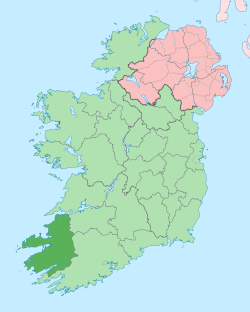Listowel
Listowel (/ˈlɪstoʊl/ LISS-tohl; Irish: Lios Tuathail, meaning "Tuathal's ringfort"[4]) is a Heritage town and a market town in County Kerry, Ireland, and is situated on the River Feale, 28 km (17 mi) from the county town, Tralee. The town of Listowel had a population of 4,820 according to the CSO Census 2016.[2]
Listowel Lios Tuathail | |
|---|---|
Town | |
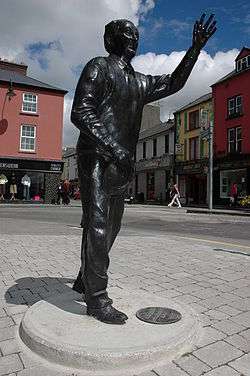 John B. Keane statue in The Small Square | |
 Coat of arms | |
 Listowel Location in Ireland | |
| Coordinates: 52.447°N 9.486°W | |
| Country | Ireland |
| Province | Munster |
| County | County Kerry |
| Area | |
| • Total | 5.4 km2 (2.1 sq mi) |
| Elevation | 27 m (89 ft) |
| Population (2016)[2] | |
| • Total | 4,820 |
| • Rank | 92nd |
| • Density | 890/km2 (2,300/sq mi) |
| Time zone | UTC±0 (WET) |
| • Summer (DST) | UTC+1 (IST) |
| Eircode routing key | V31 |
| Telephone area code | +353(0)68 |
| Irish Grid Reference | Q988338 |
| Year | Pop. | ±% |
|---|---|---|
| 1831 | 2,289 | — |
| 1841 | 2,598 | +13.5% |
| 1851 | 2,134 | −17.9% |
| 1861 | 2,273 | +6.5% |
| 1871 | 2,199 | −3.3% |
| 1881 | 2,965 | +34.8% |
| 1891 | 3,566 | +20.3% |
| 1901 | 3,605 | +1.1% |
| 1911 | 3,409 | −5.4% |
| 1926 | 2,917 | −14.4% |
| 1936 | 3,098 | +6.2% |
| 1946 | 3,311 | +6.9% |
| 1951 | 3,149 | −4.9% |
| 1956 | 3,144 | −0.2% |
| 1961 | 2,859 | −9.1% |
| 1966 | 2,822 | −1.3% |
| 1971 | 3,021 | +7.1% |
| 1981 | 3,649 | +20.8% |
| 1986 | 3,693 | +1.2% |
| 1991 | 3,597 | −2.6% |
| 1996 | 3,656 | +1.6% |
| 2002 | 3,999 | +9.4% |
| 2006 | 4,338 | +8.5% |
| 2016 | 4,820 | +11.1% |
| [3][2] | ||
Described by the organisers of Listowel's writers festival as the "Literary Capital of Ireland",[5] a number of internationally known playwrights and authors have lived there, including Bryan MacMahon and John B. Keane.
Location
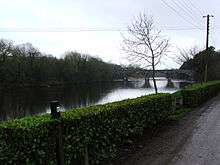
Listowel is on the N69 Limerick – Foynes – Tralee road. Bus Éireann provides daily services to Tralee, Cork, and Limerick. The nearest railway station is Tralee. Listowel used to have its own railway station on a broad gauge line between Tralee and Limerick city; however, this was closed to passengers in 1963, to freight in 1978, and finally abandoned and lifted in 1988. The station building has been preserved as a private residence.
Listowel is located at the head of the North Kerry limestone plain. Positioned in the very heart of North Kerry, on the River Feale, its hinterland is an area of mainly dairy agricultural use. The barony of Iraghticonnor[6] is to the north, with the barony of Clanmaurice to the south. Surrounding villages include Asdee, Ballybunion, Ballyduff, Ballylongford, Causeway, Duagh, Lisselton, Lixnaw, Moyvane, Finuge and Tarbert.
History
In July 2000, Listowel was officially designated as one of Ireland's 26 "Heritage Towns" – in part because of modern environmental and renewal works, but also because of its architectural heritage and "historic importance".[7]
Listowel Castle
Listowel's history dates back to at least 1303 when it first appears in the Plea Roll. Fortress to the Fitzmaurice family, the town developed around Listowel Castle and its square. The last bastion against Queen Elizabeth I in the Desmond campaign, Listowel Castle was built in the 15th century and was the last fortress of the Geraldines to be subdued. It fell after 28 days siege to Sir Charles Wilmot on 5 November 1600, who had the castle's garrison executed in the following days. The castle became the property of the Hare family, the holders of the title of Earl of Listowel, after reverting away from the Fitzmaurices, Knights of Kerry. It is now a national monument, and was subject to restoration by the Office of Public Works (OPW) from 2005. OPW tour guides are now based at the castle during the summer tourist season giving free tours of the castle.[8]
Another smaller castle at Woodford, Listowel, was built in the post-1600 period by the then Knight of Kerry.
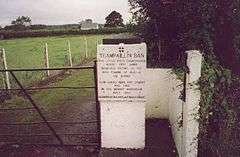
Lartigue Monorailway
Listowel played a role in Irish railway history as it was the site of the world's first monorail operation. The Listowel and Ballybunion Railway was built to the Lartigue system, with a double-engined steam locomotive straddling an elevated rail. It connected the town with Ballybunion. Coaches, with a compartment on either side of the rail, had to be kept balanced. If a cow was being brought to market, two calves would be sent also, to balance it on the other side. The calves would then be returned, one on either side of the rail. In 2003, a 1000 m long replica of the original monorailway was opened.
Listowel Mutiny
Listowel was the site of a famous mutiny which occurred during the Irish War of Independence. On 17 June 1920, members of the Royal Irish Constabulary at Listowel police station refused to obey the commanding officer's orders that they be relocated to police outposts outside of the town. The Black and Tans had occupied the town barracks, forcing the redeployment, something which was both dangerous and hopeless in the face of huge local hostility to the men in question. Police commissioner Colonel Smythe wished that the RIC constables would operate with the army in countering the IRA's fight for freedom in the more rural areas. He suggested while negotiating with the constables that they would be given the power to shoot any suspect on sight. Led by Constable Jeremiah Mee, they refused, both from a point of personal safety and possibly also from a sense of sympathy with their country men struggling against the British forces. The officers were discharged after the mutiny. The episode has come down to be known as the Listowel mutiny.
Earl of Listowel
The title of Earl of Listowel is associated with the Hare family. The current incumbent Lord Listowel is Francis Michael Hare, one of the 92 hereditary peers elected to the British House of Lords.
Holders of the title have included William Hare, 5th Earl of Listowel, who was a Labour politician and served as the last Secretary of State for India and Burma. Another member of the family was the Conservative politician John Hare, 1st Viscount Blakenham. He was the third son of the fourth Earl.
Industry
Kerry Co-op
In the 1970s many small dairies in Ireland started to merge so as to be able to compete with the larger milk companies within the European Economic Community (which Ireland joined in 1973). Dairies in County Kerry followed suit and with an injection of capital from milk suppliers in the county, it acquired the state-owned milk processing company and its creameries, together with its 42.5% stake in the private NKMP company. Additionally, six of the eight independent co-ops, which held the other 42.5%, were acquired and accordingly the private company became a subsidiary of the newly formed Kerry Co-operative Creameries Ltd (Kerry Co-op) which began trading in January 1974. Thus Kerry started out as the smallest of Ireland's six major agricultural co-operatives in 1974.
In the period from 1974 to 1979, Kerry expanded its milk business in a similar fashion to other dairy co-ops but did so on a consistently profitable basis, which was not always typical of the traditional dairy Co-op sector. EEC entry had brought better milk prices, increased milk volumes and improved farm incomes in Ireland. Kerry Co-op grew organically simply by taking the milk that came its way, processing it and meeting other farmer requirements in terms of inputs and on-farm services. Its milk supply increased from 67 million gallons in 1974 to 87 million gallons in 1978. The new co-op acquired the independent Killarney, Limerick, Mariewasere and Ballinahina Dairies (Cork) which later became part of Kerry's Dawn Dairies structure with the addition of Galway and Moate Dairies.
However, in 1979 everything changed for Kerry Co-op when the county was chosen as a pilot area for a bovine disease eradication scheme. Allied to this, milk production was further depressed due to wet summer weather in 1979 and in 1980, which meant that Kerry lost almost 20% of its milk supply. This was significant in that it happened at a time when the co-op was in the course of completing a €18 million capital expenditure programme at the NKMP plant in Listowel.[9]
Kerry Group
Kerry Group today is a leader in global food ingredients and flavours markets, and a leading branded consumer foods processing and marketing organisation in some EU markets.
Headquartered in Tralee, the Group employs approximately 290 people at its manufacturing plant in Listowel.[10]
Education in Listowel
Listowel is serviced by many primary, post-primary and post-leaving certificate education facilities. Children between five and twelve are facilitated by Presentation Primary School for girls, Scoil Realta na Maidne, for boys, and Gaelscoil Lios Tuathail, which is a mixed school. The town has two Catholic, secondary schools, Presentation Secondary School, Listowel and St. Michael's College. The town is also served by Listowel Community College, a mixed post-primary and post-leaving certificate school. The town hosts Learning Initiative of North Kerry.
Festivals and events
Listowel Races
The origin of Listowel races can be traced back to an annual gathering at Ballyeigh, Ballybunion, about nine miles from Listowel. This event, which dates to the early nineteenth century, consisted of a variety of games, horse-racing and a pre-arranged faction fight which concluded the event. Due to disturbances surrounding these fights, the meeting at Ballyeigh was suspended and racing transferred to Listowel, where the first meeting took place in 1858. The racecourse is located beside the River Feale, and two of the three entrances to the course are accessed by bridge across the river. The racecourse is called "the island" by the locals due to this fact.[11]
It is now the joint-longest racing festival in Ireland at seven days, equal in duration to the Galway races, and second in attendances only to that event. It is the last major racing festival of the summer and the last one before Christmas. Traditionally it was a meeting where farmers came to spend/gamble the money they made from the harvest but it has since grown into something larger and more wideranging.[12]
The Listowel track consists of a 1-mile, 2 furlong mile oval left-handed track with National Hunt fences and hurdles. The hurdle course is adjustable after each day's racing to give new ground. The track has been extended to allow extra race permutations and to enable the Festival Meeting in September to extend to seven days. The Listowel Racecourse is within walking distance of the town centre.
Listowel Writers' Week
Listowel is home to Ireland's oldest literary festival. Since its inception in 1970 Listowel Writers’ Week has been recognised as the primary event in Ireland's literary calendar. North Kerry is the birthplace of many of Ireland's most prominent writers, including Dr. John B Keane, Dr Bryan Mac Mahon, Professor Brendan Kennelly, Seamus Wilmot, Gabriel Fitzmaurice, George Fitzmaurice, Maurice Walsh and Robert Leslie Boland. The Writers' Week Festival was established to celebrate those writers and to provide an opportunity for other Irish writers to develop their talents and meet new audiences.
The concept of the Literary Workshop was first introduced at Writers’ Week in 1971 by Bryan MacMahon. Irish writers have shared their skills in poetry, fiction, theatre, and screen – with workshops in song writing, comic writing and storytelling also subsequently added.
Competitions were introduced, together with a series of literary awards, which have given recognition to new writers over the last number of years. In that time many Irish and international literary figures have gathered in Listowel at the annual festival to celebrate the work of new and established writers.
The total prize fund of €35,000 includes the Kerry Group Novel of the Year and The Pigott Poetry Prize.
The event takes place in an atmosphere of learning and celebration which gives new and established writers an opportunity to discuss their work before a national and international audience.
Under the leadership of its President Colm Tóibín, together with literary advisors Professor Brendan Kennelly, Colm Tóibín, Seamus Hosey, Lawrence Block, Michael Collins and Jennifer Johnston, Writers' Week provides a programme of literary events including lectures, readings, workshops, book launches, seminars, theatre, literary and historical tours, art exhibitions, music and dance.
Participants have included: Nobel Laureate and Booker Prize-winner J. M. Coetzee, Nobel Laureate Seamus Heaney, Booker Prize winners Kazuo Ishiguro, John Banville, James Kelman and Anne Enright, Poets Laureate Ted Hughes, Carol Ann Duffy, and Andrew Motion, playwrights Tom Murphy, Brian Friel, Roddy Doyle, Frank McGuinness and Hugh Leonard, poets Michael Hartnett, Leland Bardwell, John Montague, Yevgeny Yevtushenko, Nuala Ní Dhomhnaill, Roger McGough, Rita Ann Higgins and Kate Cruise O'Brien, and other novelists and writers including Blake Morrison, Chris Whyte, Lionel Shriver, Colm Tóibín, Jennifer Johnston, John McGahern, Joseph O'Neill, Sebastian Barry, Joseph O'Connor, Hugo Hamilton, Edna O'Brien, Douglas Kennedy, Patrick McGrath, William Trevor, Colum McCann, Gerard Donovan, Frank McCourt, Irvine Welsh, Robyn Rowland, Andrew Lindsay, Michael Cunningham, Jane Urquhart, Anatoly Kudryavitsky, Cees Nooteboom, Michael Dibdin, Abdel Bari Atwan, Clive James, Melvyn Bragg, Alain De Botton, Lloyd Jones, Robert Fisk, Jung Chang, Terry Jones, Gabriel Byrne, and Graham Norton.
John B. Keane of Listowel wrote:
- "Beautiful Listowel, serenaded night and day by the gentle waters of the River Feale.
- Listowel where it is easier to write than not to write,
- Where first love never dies, and the tall streets hide the loveliness,
- The heartbreak and the moods, great and small,
- Of all the gentle souls of a great and good community.
- Sweet, incomparable hometown that shaped and made me."[5]
Listowel Food Fair
The Listowel food Fair has been running annually since 1995.[13] The festival promotes local artisan food products, and attracts celebrity chefs, nutritionists and artisan food entrepreneurs.
Sport
Listowel Emmets is a Gaelic Athletic Association (GAA) club which supports the traditional Irish sports of hurling, camogie, Gaelic football, handball and rounders, plus music, dance and the Irish language. The club has a tradition of GAA involvement and achievement since June 1885 when Listowel GAA (The Feale Amateurs) was established as a GAA branch. In 1956 Emmets GAA Club was formed and in the following year the senior, intermediate and minor North Kerry League titles were won. In 1979, the Listowel Emmets GAA pitch next to St. Michaels College was closed for redevelopment; it re-opened again in 1981, and was renamed in honour of Frank J Sheehy who was appointed as Chairman to the County Board in 1953.
Listowel Celtic is the local soccer club, playing in the Premier A division of the Kerry District League. Listowel also has clubs involved in tennis, athletics, rugby, basketball, badminton and cricket. Listowel also hosts a 24hr running race; the Listowel Endurance Festival.
Architecture
Listowel's architectural features include the four-arch bridge traversing the River Feale at the entrance to the town. Dating from 1829, according to local tradition this bridge (referred to locally as the "Big Bridge") replaced a smaller wooden structure, which had been destroyed in floods.
Local plasterer and builder Pat McAuliffe (1846–1921) used stucco or external plaster to decorate the façades of townhouses and shops in the town and surrounding area. A native of Listowel, McAuliffe created a number of plasterwork works, including "The Maid of Erin", which depicts a romantic image of Mother Ireland surrounded by a harp, a wolfhound and other symbols of Ireland. The Maid was at the centre of a controversy in 1999 when a new owner decided to "cover her dignity" and painted a dress on her famous bosom. A debate ensued and he was persuaded to return her to her original semi-nude state.
- Maid of Erin
- Plaster relief
 Emporium
Emporium
Notable people
Art and academics
|
Military and politics
Sport
|
Related communities
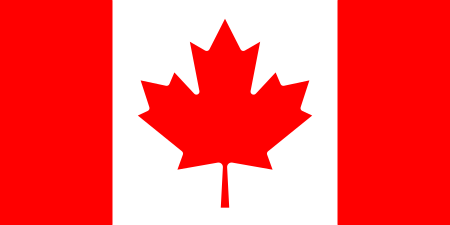


Notes
- "Population Density and Area Size 2016". CSO. Retrieved 9 July 2019.
- "Sapmap Area – Settlements – Listowel". Census 2016. CSO. 2016. Retrieved 12 January 2018.
- "Archived copy". Archived from the original on 2010-09-20. Retrieved 2010-08-12.CS1 maint: archived copy as title (link) and http://www.histpop.org Archived 2016-05-07 at the Wayback Machine. Post 1991 figures include environs of Listowel. For a discussion on the accuracy of pre-famine census returns see JJ Lee "On the accuracy of the pre-famine Irish censuses" in Irish Population, Economy and Society edited by JM Goldstrom and LA Clarkson (1981) p54, and also "New Developments in Irish Population History, 1700-1850" by Joel Mokyr and Cormac Ó Gráda in The Economic History Review, New Series, Vol. 37, No. 4 (November 1984), pp. 473-488.
- "Lios Tuathail/Listowel". Placenames Database of Ireland. Government of Ireland - Department of Arts, Heritage and the Gaeltacht and Dublin City University. Retrieved 9 July 2019.
- "Listowel Writers' Week – Information – Listowel". Archived from the original on 18 December 2007.
- Barony of Iraghticonnor at GENUKI. Retrieved 9 September 2010
- Listowel Urban District Council, Kerry Local Authorities, Annual Report
- "Archived copy". Archived from the original on 2015-07-21. Retrieved 2015-07-28.CS1 maint: archived copy as title (link)
- version 8 homepage Archived 2007-11-17 at the Wayback Machine
- Agreement reached in pay dispute between Kerry Group and 290 Listowel workers
- Listowel Race Co
- Go Racing – Listowel
- "Listowel Food Fair – About Us". listowelfoodfair.ie. Retrieved 25 May 2018.
- "5 things you need to know about... Glassland director Gerard Barrett". Joe.ie. Retrieved 25 May 2018.
Barrett hails from near Listowel in Kerry in an area that is home to esteemed writers such as Brendan Kennelly, Bryan McMahon and the great John B Keane
- http://www.kerrywritersmuseum.com/george-fitzmaurice/
- "Talented actor and short story writer". The Irish Times. Retrieved 25 May 2018.
- "Obituary – John Moriarty". The Guardian. 30 August 2007.
- "Biography – Ó Rahaile, Tomás (1882–1953)" (in Irish). Ainm.ie. Retrieved 25 May 2018.
- "UCD Archives – Alfred O'Rahilly Papers" (PDF). University College Dublin. Retrieved 25 May 2018.
Born in Listowel, County Kerry in October 1884 [..Alfred O'Rahilly was..] educated at Blackrock College Dublin and University College Dublin
- "Biography – Ní Rathaille, Sisile (1894–1980)" (in Irish). Ainm.ie. Retrieved 25 May 2018.
- "Kerry Writers Museum – Maurice Walsh". Retrieved 25 May 2018.
- "John Connors VC". vconline.org.uk. Retrieved 25 May 2018.
- "Jimmy Deenihan TD – Fine Gael Press Office". Fine Gael. Retrieved 25 May 2018.
Jimmy [Deenihan] is married [..] and they live in Listowel.
- United States Congress. "Listowel (id: S000773)". Biographical Directory of the United States Congress. Retrieved 25 May 2018.
- "Scoil Réalta na Maidne kids stand by their man". 21 September 2006. Retrieved 25 May 2018.
- "Kennelly brothers so aware of stark contrasts". 6 January 2002. Retrieved 25 May 2018.
- "Garry McMahon 1937–2008". Listowel Emmets. Archived from the original on 2009-09-11. Retrieved 2009-09-04.
- "Monte Sereno explores sister city relationship". Los Gatos Weekly Times. Retrieved 8 June 2009.
- Sister Cities - City of Shawnee.. Retrieved 9 September 2010.
References
- Prideaux, J.D.C.A. (1981). Odd Man Out, in The Irish Narrow Gauge Railway, pp. 26–27. David & Charles (Publishers) Ltd. ISBN 0-7153-8071-0.
- Gaughan, Father Anthony. Listowel and its vicinity. 1973.
- Gaughan, Father Anthony. Listowel and its vicinity Since 1973. 2004. ISBN 1-85607-912-0
- Fitzmaurice, Gabriel. The Listowel Literary Phenomenon. 1994. ISBN 1-874700-87-7
External links
| Wikimedia Commons has media related to Listowel. |

